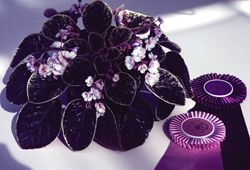 Proper culture and a desire for house plants are the keys to a well grown African violet like this.
Proper culture and a desire for house plants are the keys to a well grown African violet like this.Once found only in the coastal woods of east Africa, African violets (Saintpaulia ionantha) are now among the most popular indoor plants. They are easy to grow and offer a wealth of beautiful flowers. For the indoor gardener with limited space, African violets have an added attraction — with sound cultural practices, they can be grown quite successfully on window sills.
Classification and Varieties
African violets are available in a wide range of colors and types. You may choose from several hundred varieties depending upon the flower color, form and plant characteristics you prefer.
Flower color varies from blue to violet, lavender, pink, red-violet, blue-violet, lavender-pink and white. Flowers may be single, double, semi-double, star-shaped, fringed or ruffled. Some varieties produce flowers with two or more rows of petals on one color with the rest fringed in a different color. Leaf types are described as plain, quilted, spidered, ruffled, fringed, scalloped, spooned, pointed and variegated.
Plant sizes, depending upon variety, are classed as miniature (6 to 8 inches or less in diameter); semi-miniature (6 to 8 inches); standard (8 to 16 inches); and large (over 16 inches).
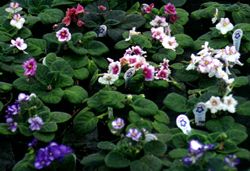 Several hundred varieties of African violet exist.
Several hundred varieties of African violet exist.
Conditions for Culture
Light
African violets grow well, stay healthy and produce abundant flowers when they get the right amount of light.
Intensities of 1,000 foot-candles of light for 6 to 8 hours per day give good results. This compares to the light intensity of a sunny, east or west window or a bank of four fluorescent shop lights. Violets also will tolerant low light levels (200 to 500 foot-candles).
South or west windows offer the best light in winter. During warmer seasons, windows with east or north exposures are best.
Insufficient light is probably the most common reason for failure of African violets to flower. If violets are growing in too little light, the leaves become darker green and thin, petioles or leaf stems are very long and weak, and the plants flower very little if at all.
Violets exposed to too much sunlight will have pale yellow-green leaves. Bleached-out, burned or dead areas also may be present. A little study and testing may be needed to determine if the light intensity or duration is sufficient in your home. Where plants must be grown in windows with bright light, you may need to use a very sheer curtain to diffuse and reduce the light reaching the plants. In an excessively high light intensity, plants can be scorched or at best will be quite compact because of short stems and slower growth.
African violets can be easily grown using artificial light. An intensity of approximately 600 foot-candles for 14 to 16 hours per day is recommended. Inexpensive timers are available to automatically turn lights on and off.
Fluorescent lights are most frequently used and can be arranged in tiers or attached to shelves for a convenient and attractive light source. The tubes should be 12 to 15 inches above the tops of the plants. A shelf containing two or more 20- to 40-watt tubes will grow numerous plants. Several companies manufacture fluorescent tubes specifically designed for plant growth. The light emitted contains more usable radiant energy. In most cases, however, indoor gardeners enjoy success with less expensive "Cool White" tubes. One or two incandescent bulbs may be used with the fluorescent tubes.
Standard incandescent bulbs alone are not recommended as a light source because of their poor light spectrum and the heat they produce. Specially designed incandescent spotlights are available for plants in 75 and 150 watts. They provide useful levels of light energy when located about 12 to 18 inches away from the plants.
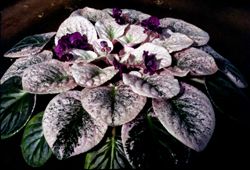 Healthy violets require proper temperature, light and humidity.
Healthy violets require proper temperature, light and humidity.Temperature
The most attractive violets are grown at a nighttime temperature of 65° to 70°F and a daytime temperature of 70° to 90°F. Plants grown at temperatures below 60°F will be deformed. The leaves may curl down, cup and become brittle. Flowers may be deformed and discolored. Also foliage maybe a light green at cooler temperatures, especially when grown under correct light conditions. Plants growing in drafts or touching glass window panes may have injured foliage.
For best results, avoid placing the plants where temperatures are above 90°F or below 60°F.
Humidity
Humidity, or the amount of water vapor suspended in air, is important to good violet growth. Even though violets grow and flower in humidity ranges of average homes. The most successful plants are grown in a higher humidity. Devices are available that increase the humidity in the home and benefit both plants and people.
Where a few plants are concerned, humidity may be increased by setting the pots in watertight metal or plastic trays filled with water and gravel or pebbles. Maintain a shallow level of water in the tray. Do not allow the pots to sit in water; set them on pebbles or on inverted shallow pot saucers.
Misting is not recommended.
A recent trend for easier control of humidity is to plant violets in large glass goblets, aquariums or terrariums.
Soil Moisture
Soil moisture and proper watering are critical to your success in growing African violets. Plants can die from too much or too little water. How often to water and how much vary depending on the soil, pot and plant sizes, and environmental conditions. For this reason, you'll have to learn the moisture requirements of your plants and develop an individual watering schedule.
Moisture meters and devices are available which measure soil moisture. While some of these are fairly reliable, an easier (and less expensive) method is to simply touch the soil surface with your finger tips. Allow the soil to become slightly dry between waterings, but don't allow it to become excessively dry as wilting can cause root damage.
Apply water until it drains out the bottom of the pot. Pour off the excess after 20 to 30 minutes.
Cold water (55°F or below) splashed on the leaves causes light green, discolored areas called ring spot. If the temperature difference between the leaves and water is as little as 10°F, damage can occur. But damage can be prevented if the water is brought to room temperature.
Many violet growers prefer to water from the bottom rather than the top of the pot. This works well, but it doesn't leach salts that can accumulate in the soil. All plants should be watered occasionally from the top with warm water to remove dust and to wash out salts.
Plants in containers without drainage holes are much more subject to overwatering problems such as root rot or stem rot.
Plants in high light and low humidity require more frequent watering than those in low light and high humidity. A coarse, well-drained soil mixture requires more frequent watering than a heavy, poorly drained soil mixture.
Maintaining the correct soil moisture becomes more of a problem as plants outgrow their pots. Crowded plants should be repotted into the next larger size pot.
Soils
African violets grow in a very wide range of soils and soil mixtures. Gardeners get the best results with well drained, well aerated soil that contains a high percentage of humus or organic matter. Generally, a mixture of 1 part leaf mold, 1 part peat moss, 1 part sand and 2 parts loamy top soil gives good results.
Artificial mixes such as peat-vermiculite and peat-perlite are excellent for growing violets. They are relatively clean and will be free of most insects and diseases. A mixture may consist of equal parts of soil, peat moss and horticultural perlite. Vermiculite may be substituted for perlite.
Some violet growers prefer the artificial mixtures because they are consistent in quality, while sand and soil can vary. Violets grow best in a sterilized potting soil or commercial African violet soil mixture.
Potting
When potting, remember that violet leaves, stems and root systems are very tender and easily broken.
Older plants usually have more than one crown. After you have gently removed the plant from the pot, divide the crowns by cutting through the root ball with a sharp knife. Be careful not to destroy all the roots or to shake all the soil from the root systems.
When repotting, partially fill the pot with soil. Set the plant so the crown is slightly above the soil level (approximately ¼ to ½ inch below the rim of the pot.) Gently firm the soil around the old root ball.
Remember plants do better in pots with drainage holes. A thin layer of gravel, pieces of stockings, or pieces of broken pots should be used to prevent soil from washing through the holes.
Fertilization
Violets, like most plants, respond well to regular doses of fertilizer. Most violet hobbyists prefer to use liquid or water-soluble fertilizers such as 20-20-20 every four to six weeks. Dry fertilizers and slow-release or encapsulated fertilizers can also be used. With a dry fertilizer, be sure the soil is moist before you use it.
Regardless of which kind of fertilizer you use, read and follow the manufacturer's recommendations.
Plants in less than ideal conditions or in non-active stages of growth may require less fertilizer. African violets are very sensitive to a build-up of soluble salt which can damage plant roots. Many indoor gardeners get the best results using one-third to one-half the recommended amount of fertilizer; however, too little fertilizer may cause a slow-down in growth and/other deficiency symptoms. Note, too, that excess fertilizer can result in symptoms that sometimes mimic deficiencies. A soil test will be your best guide in figuring out the problem.
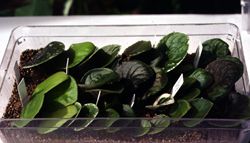 Violets can be propagated through leaf cuttings.
Violets can be propagated through leaf cuttings.Propagation
African violets are easily propagated by division (see Potting). You also can get more violets with leaf-petiole cuttings; however, this takes longer to produce a flowering plant. African violets can be grown from seed, but only a few varieties will come true. A flowering plant can be produced from a leaf cutting or a seed in about 10 months under good growing conditions.
The most trouble-free method of propagating violets is to make a greenhouse with two 8 x 12-inch clear plastic storage boxes. Fill the bottom of one box with 4 inches of potting soil. Moisten the soil and then stick overlapping violet leaves about ½ inch into the soil. Place the clear plastic bottom of the other storage box on top and tape the sides. Place the sealed box in an east or south window. Young violet plants will appear in 8 to 10 weeks and be ready for transplanting in three months.
When potting newly rooted cuttings, it is wise not to add fertilizer. However, when dividing or shifting large plants to larger pots, you may want to use ¼ to 1/3 teaspoon of a complete African violet fertilizer for each 5-inch pot volume of soil mixture. Thoroughly mix the fertilizer into the soil to prevent root injury. A slightly acid soil mixture (pH 6.0 to 6.5) will give best results.
Common Insects and Problems of African Violets
| Aphids | Insect, usually green or black, 1/8" long, called plant lice. Injure plants by sucking the plant sap. | Check with your county Extension agent for the latest and safest recommendations on chemicals.* |
| Cyclamen Mites | Extremely small insects, not visible with magnification. Insects feed on growing tip of plants. Corky layers develop over injury causing puckering, twisting and distortion of leaves in center of plant. Leaves may be excessively hairy, stunted and hard. Severe infections cause a mass of tiny, hairy and distorted leaves in center of plant. | See above. |
| Red Spiders | Injure by puncturing and sucking sap. In large numbers, develop a web over leaves, flowers, etc. Plants appear stunted. Insects small, reddish in color and visible with naked eye. If in doubt shake leaf on white piece of paper. Insects visible crawling. | See above. |
| Mealy Bugs | White cottony mass of eggs and insects in crown of plant. As population increases, insects distribute themselves on stem and underside of leaves. Insects feed by piercing and sucking sap. Insects about ¼" in length with a waxy coating. | See above. |
| Botrytis Blight | A disease infecting flowers, leaves, petioles. Causes decay, flowers develop water-soaked appearance. Affected plant parts become covered with gray mold. | Improve air movement, reduce humidity. See above. |
| Root and Crown Rot | Attacks stems, leaves and petioles in contact with soil. May cause complete wilting of plant if entire stem is attacked. Individual leaves wilt if infected. | Use sterilized well-drained soil. Use clean plants. Discard badly diseased plants. See above. |
| * Specific chemicals are omitted from this publication because of frequent changes in pesticide development and regulation. | ||
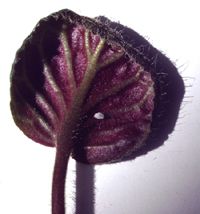 Mealy bugs feed on plant stems and leaves.
Mealy bugs feed on plant stems and leaves.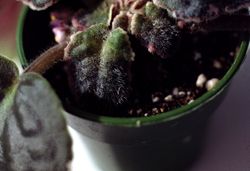 This plant shows typical symptoms of cyclamen mites.
This plant shows typical symptoms of cyclamen mites.
Status and Revision History
Published on Feb 24, 2009
Published with Full Review on Feb 14, 2012
Published with Full Review on Feb 01, 2016
Published with Full Review on Oct 12, 2022


























































